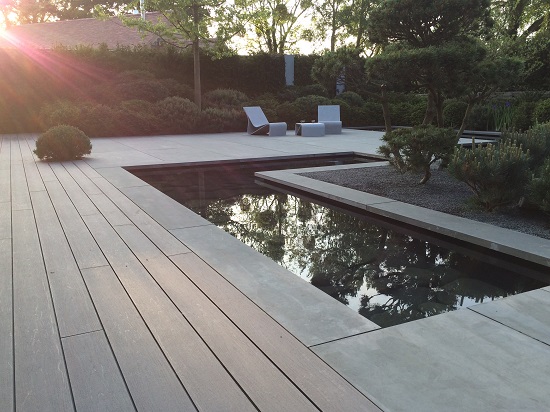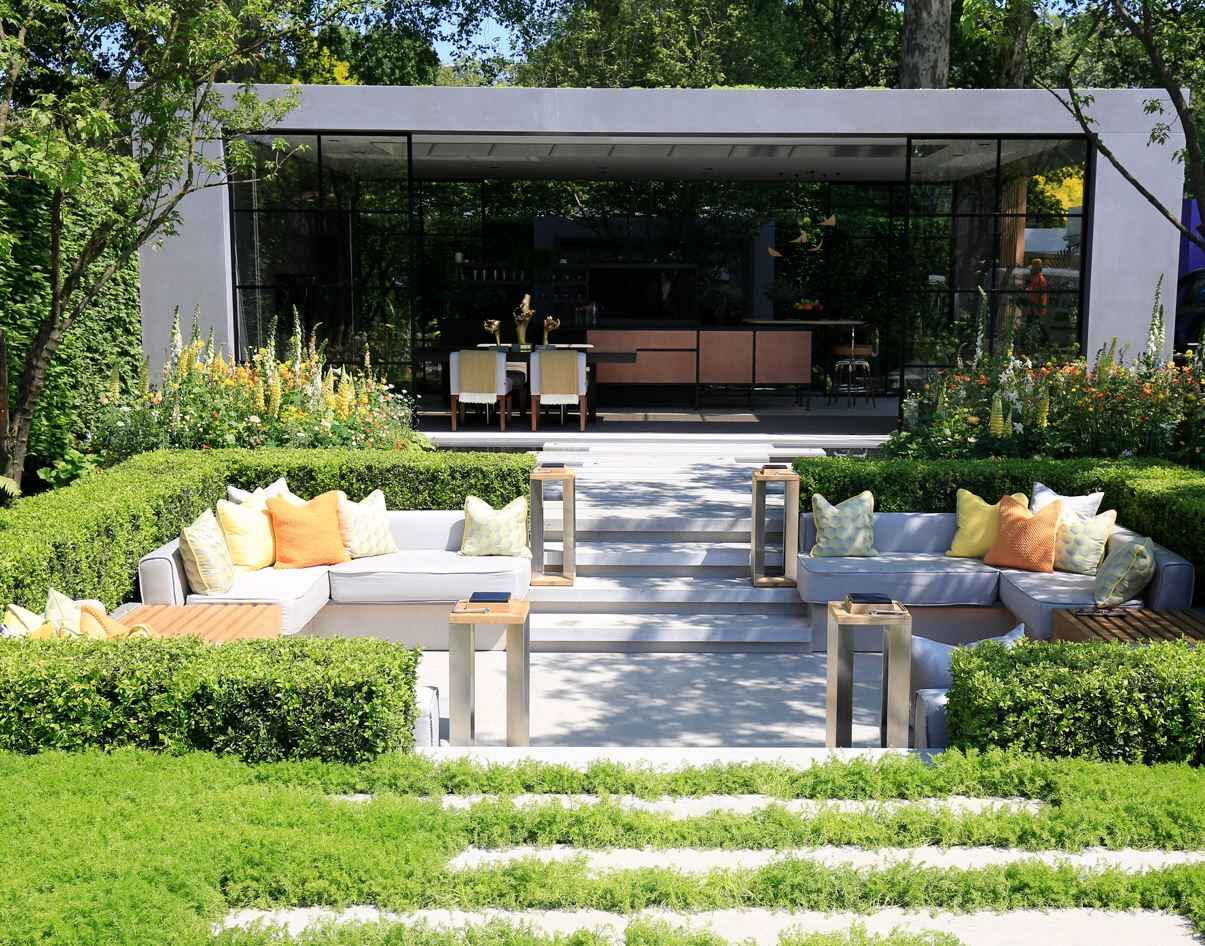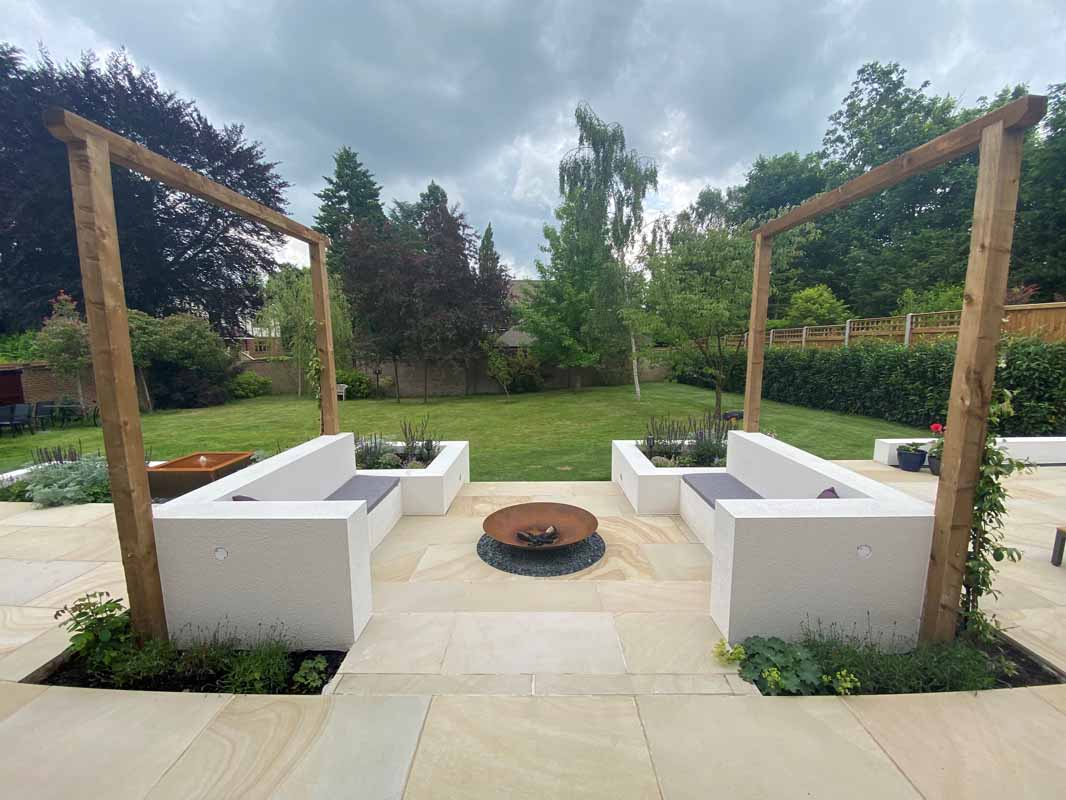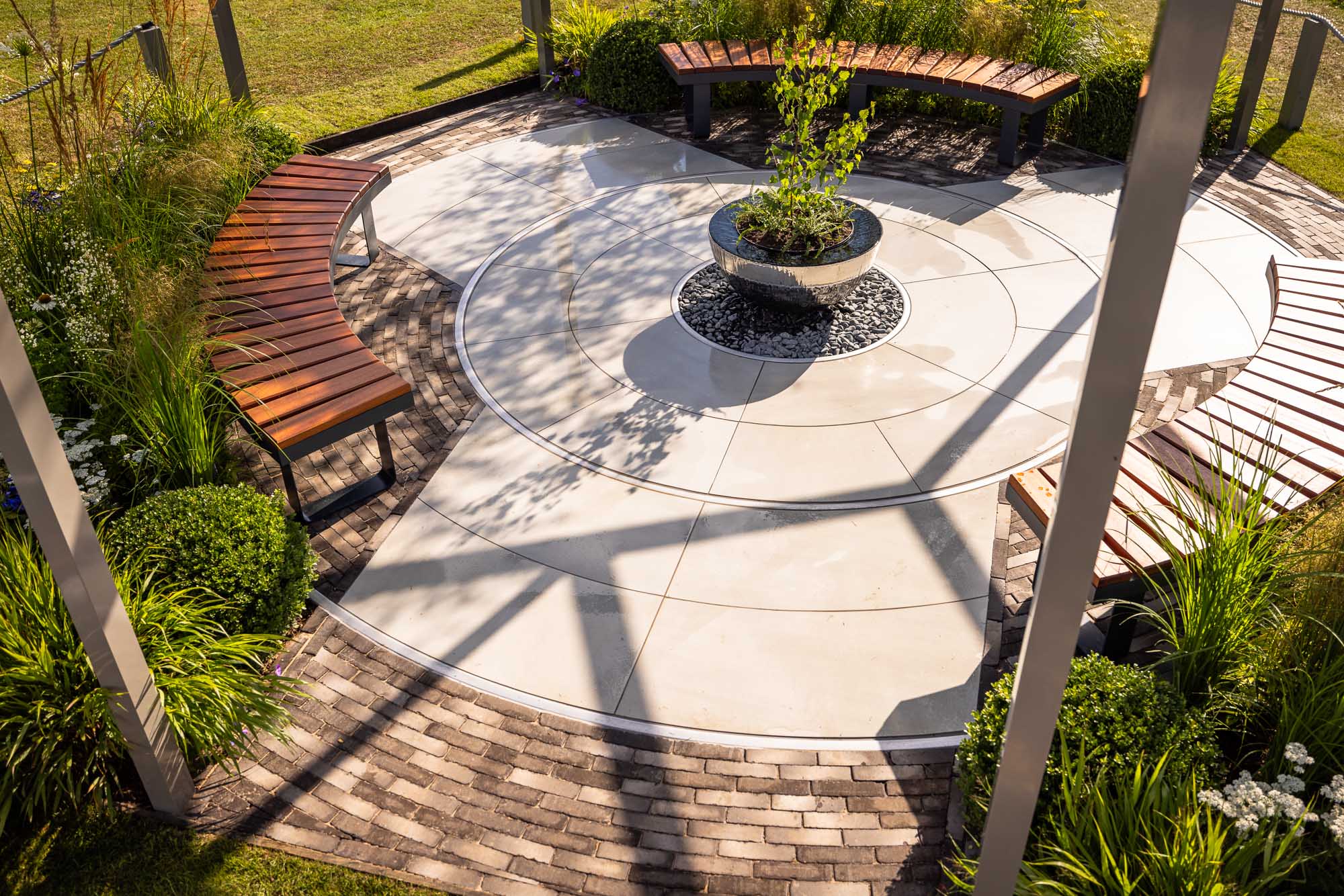Inserting a minimalist, Japanese-style garden into the middle of quintessentially English countryside could have resulted in something that looked utterly out of place. Instead, Matt Keightley of Rosebank Landscaping created a restrained garden that reinterprets the style to make it completely at home.
Grey Yorkstone, taken by Matt Keightley, Rosebank Landscaping.
Three classic design elements
Matt started with a completely blank space, as the area was the tarmacked hard-standing for a set of garages (now refurbished into a three-bedroom house). After in-depth discussions with the owner, who particularly wanted the Japanese look, Matt took the three classic elements of a Japanese garden—water, hard landscaping and sculptural planting—and put them together in a way that draws in the surrounding countryside, rather than repels it. Clipped yew and dwarf pines add texture as well as shape, while multi-stemmed magnolias, Iris sibirica, and Pin Oaks (Quercus palustris) bring moments of colour through the seasons.
Picture: Matt Keightley
The choice of paving
Matt chose Grey Yorkstone to partner the other two elements. “Grey Yorkstone gives the planting a muted structure. In the normal light of day, where planting can appear ordinary, against this stone it really pops out.”
The paving consists of two notable paving formats. The extra large slabs measure 1680 x 980mm and took a crane and stone magnet to get them into place. “They make the space more exciting and interesting, but it's a restrained way to do it, and they have a clean, contemporary look because of the minimal joints.” One of the lovely aspects of Grey Yorkstone is the character it offers, brought to the fore in the extensive slabs. “”With the natural marbling and veining,” said Matt, “every piece feels like a piece of sculpture.”
Picture: Matt Keightley
The importance of water
In contrast, Grey Yorkstone planking edges the water. “It draws the eye from the source of the water, along the rill and up the vertical stone at the end of the garden,” says, Matt, “which makes the space feel like a panorama, with a sense of journey even when standing still.”
The shape of the rill also plays its part in this, in a clever balance of dynamism and serenity. Creating a mirror for the planting and boulders and maintaining the garden's rectilinear stability, the water nevertheless zigzags across the garden, taking the eye to the distant corner.
A drainage challenge
Its simple lines hide a complicated build. As the rill turns a corner, it couldn't take the fall in paving normally built in for drainage, so all the stone is perfectly level, laid on pedestals, without pointing, so water drains through to the concrete base hidden below, where the fall is built in. This made the jointing even more critical. “The tolerances London Stone gave us were fantastic,” says Matt. “We could set slabs with a 3-5mm joint all round for a really crisp feel.”
Meanwhile, the pumping and filtration unit for the rill is placed well outside the garden. “This is so that you only get to experience the garden, with no perception of how it works, and is calm as you walk through.”
Picture: Matt Keightley
Think like a photographer
In 2017, these photos won Matt first prize in our photo competition for pictures featuring our products and were featured in our brochure.
Looking at a garden like a photographer is a useful trick when planning a garden. Matt's Gold-winning Chelsea experiences focused his attention on this. “After Year One at Chelsea, someone said to me that you've got to start thinking about design with a photographer's eye. Obviously, this is a private garden so others aren't going to see it, but you still need framing—particularly views through space so that clients can appreciate the design fully, wherever they're standing within that space."
When a design is as restrained as this one, attention to detail is all the more important. “Lining up joints in stone, placing every boulder, using trees to frame the water behind—you become obsessed with optimising views,” adds Matt.
Picture: Matt Keightley
If you're thinking about a new design for your garden, try taking photos to help you see it with an objective eye.


/filters:quality(60)/mediadev/media/menu-pics/all-porcelain.jpg )
/filters:quality(60)/mediadev/media/menu-pics/luxury-italian.jpg )
/filters:quality(60)/mediadev/media/menu-pics/premium-italian.jpg )
/filters:quality(60)/mediadev/media/menu-pics/budget-porcelain.jpg )
/filters:quality(60)/mediadev/media/menu-pics/large-format-porcelain.jpg )
/filters:quality(60)/mediadev/media/menu-pics/wood-effect-porcelain.jpg )
/filters:quality(60)/mediadev/media/menu-pics/porcelain-planks.jpg )
/filters:quality(60)/mediadev/media/menu-pics/porcelain-setts.jpg )
/filters:quality(60)/mediadev/media/menu-pics/browse-all-paving.jpg )
/filters:quality(60)/mediadev/media/menu-pics/stone-paving.jpg )
/filters:quality(60)/mediadev/media/menu-pics/interior-tiles.jpg )
/filters:quality(60)/mediadev/media/menu-pics/stone-effect-porcelain.png )
/filters:quality(60)/mediadev/media/menu-pics/wood-effect-porcelain.png )
/filters:quality(60)/mediadev/media/menu-pics/grey-porcelain.png )
/filters:quality(60)/mediadev/media/menu-pics/beige-porcelain.png )
/filters:quality(60)/mediadev/media/menu-pics/dark-porcelain.png )
/filters:quality(60)/mediadev/media/menu-pics/light-porcelain.png )
/filters:quality(60)/mediadev/media/menu-pics/patio-grout.jpg)
/filters:quality(60)/mediadev/media/menu-pics/primers.jpg)
/filters:quality(60)/mediadev/media/menu-pics/porcelain-blades.jpg)
/filters:quality(90)/mediadev/media/menu-pics/drainage.jpg)
/filters:quality(60)/mediadev/media/menu-pics/cleaners.jpg)
/filters:quality(60)/mediadev/media/menu-pics/all-stone-paving.jpg )
/filters:quality(60)/mediadev/media/menu-pics/all-sawn-paving.jpg )
/filters:quality(60)/mediadev/media/menu-pics/all-riven-paving.jpg )
/filters:quality(60)/mediadev/media/menu-pics/indian-sandstone.jpg )
/filters:quality(60)/mediadev/media/menu-pics/limestone-paving.jpg )
/filters:quality(60)/mediadev/media/menu-pics/granite-paving.jpg )
/filters:quality(60)/mediadev/media/menu-pics/slate-paving.jpg )
/filters:quality(60)/mediadev/media/menu-pics/yorkstone-paving.jpg )
/filters:quality(60)/mediadev/media/menu-pics/stone-pavers.jpg )
/filters:quality(60)/mediadev/media/menu-pics/cobbles-setts.jpg )
/filters:quality(60)/mediadev/media/menu-pics/plank-paving.jpg )
/filters:quality(60)/mediadev/media/menu-pics/paving-circles.jpg )
/filters:quality(60)/mediadev/media/menu-pics/bespoke-paving-1.jpg )
/filters:quality(60)/mediadev/media/menu-pics/edging-stones-1.jpg )
/filters:quality(60)/mediadev/media/menu-pics/prestige-stone.jpg )
/filters:quality(60)/mediadev/media/menu-pics/grey-blue-stone.png)
/filters:quality(60)/mediadev/media/menu-pics/swatch-black-dark.jpg )
/filters:quality(60)/mediadev/media/menu-pics/swatch-buff-beige-white.jpg )
/filters:quality(60)/mediadev/media/menu-pics/sealants.jpg)
/filters:quality(60)/mediadev/media/menu-pics/all-clay-paving.jpg )
/filters:quality(60)/mediadev/media/menu-pics/alpha-clay-pavers.jpg )
/filters:quality(60)/mediadev/media/menu-pics/cottage-garden-clay-pavers.jpg )
/filters:quality(60)/mediadev/media/menu-pics/kessel-garden-clay-pavers.jpg )
/filters:quality(60)/mediadev/media/menu-pics/artisan-clay-pavers.jpg )
/filters:quality(60)/mediadev/media/menu-pics/grey-blue-clay-paver.png )
/filters:quality(60)/mediadev/media/menu-pics/red-brown-clay-pavers.png )
/filters:quality(60)/mediadev/media/menu-pics/beige-buff-clay-pavers.png )
/filters:quality(60)/mediadev/media/menu-pics/composite-decking.jpg )
/filters:quality(60)/mediadev/media/menu-pics/designboard-decking.jpg )
/filters:quality(60)/mediadev/media/menu-pics/classic-designboard.jpg )
/filters:quality(60)/mediadev/media/menu-pics/brushed-designboard.jpg )
/filters:quality(60)/mediadev/media/menu-pics/grooved-designboard.jpg )
/filters:quality(60)/mediadev/media/menu-pics/millboard-decking.jpg )
/filters:quality(60)/mediadev/media/menu-pics/grey-decking.jpg )
/filters:quality(60)/mediadev/media/menu-pics/black-charcoal-decking.jpg)
/filters:quality(60)/mediadev/media/menu-pics/brown-decking.jpg)
/filters:quality(60)/mediadev/media/menu-pics/all-build-deck.png )
/filters:quality(60)/mediadev/media/menu-pics/stone-cladding.jpg )
/filters:quality(60)/mediadev/media/menu-pics/all-garden-walling-1.jpg )
/filters:quality(60)/mediadev/media/menu-pics/facing-bricks.jpg )
/filters:quality(60)/mediadev/media/menu-pics/garden-screening.jpg )
/filters:quality(60)/mediadev/media/menu-pics/all-steps-coping.jpg )
/filters:quality(60)/mediadev/media/menu-pics/stone-garden-steps.jpg )
/filters:quality(60)/mediadev/media/menu-pics/sawn-steps.jpg )
/filters:quality(60)/mediadev/media/menu-pics/riven-steps.jpg )
/filters:quality(60)/mediadev/media/menu-pics/yorkstone-steps.jpg )
/filters:quality(60)/mediadev/media/menu-pics/bespoke-steps.jpg )
/filters:quality(60)/mediadev/media/menu-pics/porcelain-steps.jpg )
/filters:quality(60)/mediadev/media/menu-pics/off-the-shelf.jpg )
/filters:quality(60)/mediadev/media/menu-pics/stone-coping.jpg )
/filters:quality(60)/mediadev/media/menu-pics/sawn-coping.jpg )
/filters:quality(60)/mediadev/media/menu-pics/riven-coping.jpg )
/filters:quality(60)/mediadev/media/menu-pics/yorkstone-coping.jpg )
/filters:quality(60)/mediadev/media/menu-pics/bespoke-coping.jpg )
/filters:quality(60)/mediadev/media/menu-pics/stone-pier-caps.jpg )
/filters:quality(60)/mediadev/media/menu-pics/porcelain-coping.jpg )
/filters:quality(60)/mediadev/media/menu-pics/all-bespoke-services.jpg )
/filters:quality(60)/mediadev/media/menu-pics/bespoke-paving-2.jpg )
/filters:quality(60)/mediadev/media/menu-pics/bespoke-steps-1.jpg )
/filters:quality(60)/mediadev/media/menu-pics/bespoke-coping-1.jpg )
/filters:quality(60)/mediadev/media/menu-pics/edge-profiles.jpg )
/filters:quality(60)/mediadev/media/menu-pics/masonry-services.jpg )
/filters:quality(60)/mediadev/media/menu-pics/deluxe-pergolas.jpg )
/filters:quality(60)/mediadev/media/menu-pics/proteus-pergolas.jpg )









